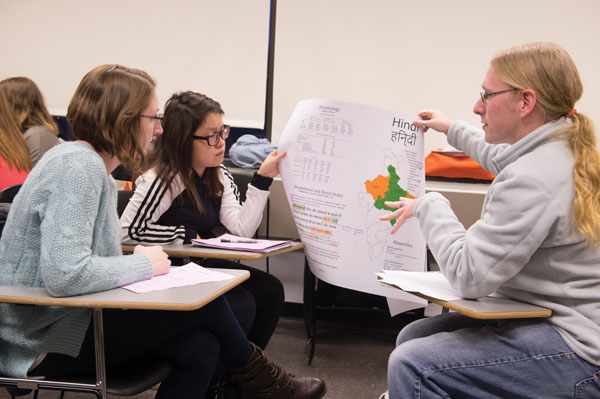
From left, students Judy Golden, Xiaomeng Lin and David Räcker discuss and contrast the Hindi language relative to English during a class project.
New ground has been broken in the College of Education with the creation of a Master of Arts in Language and Learning, a unique, graduate-level program aimed at students who are interested in language-related topics but do not envision teaching in a K-12 school system.
You won’t find a comparable master’s program anywhere in New York State, according to Fredonia’s College of Education leaders, or another SUNY campus that offers Fredonia’s broad range of specializations in this field (TESOL, Language Policy, Bilingualism/Multilingualism, Heritage Languages and Sociolinguistics).
“This M.A. in Language and Learning is meant to be interdisciplinary in nature, allowing students to enroll in the M.A. degree while choosing a specialization in which to concentrate,” explained Karen Lillie, assistant professor of TESOL/Bilingual Education.
It was through communication with current and prospective students that the College of Education learned of considerable interest in TESOL-related studies that are not connected to New York State certification.
“We conducted a needs analysis of program options comparatively across the SUNY system and there are M.A. or M.S. degrees in either TESOL, which leads to certification, or in Linguistics, but there is no known program similar to this new degree,” Dr. Lillie added.
Housed in the Department of Language, Learning and Leadership, the new program is designed to serve a varied population: international students who plan to teach English in their home countries; working professionals seeking new knowledge and a master’s degree; teachers who work with a growing number of language learners; and students with strong interests in language and learning topics who plan to pursue a doctorate. Its first students were enrolled in the Fall 2015 semester.
Fredonia already offers M.S. TESOL programs and two Advanced Certificates in TESOL and Bilingual Education that, unlike the new program, are intended for students who want to work in a K-12 setting in New York State.
Each specialization within the M.A. in Language and Learning has its own audience.
The TESOL specialization — the most popular option to date — also often appeals to international students or those who plan to work internationally or in other states. Others simply do not want New York State TESOL K-12 certification, but still work in the state with adults.
Bilingualism/Multilingualism is for people who want to work in jobs which deal with multicultural issues or concerns, or for school principals and other administrators who want to learn more about working with bilingual and multilingual children, families and employees.
Heritage Languages is geared to people concerned with the teaching and learning of languages which otherwise might be lost to future generations.
“Heritage Languages also means revitalizing and maintaining languages so that they are more widely used, such as Welsh, Hawaiian and Gaelic,” Lillie said.
Not only does having a master’s degree boost employment prospects, it’s sometimes required in some areas, such as teaching in New York or Pennsylvania, Lillie explained.
“For those students who are education majors, they should consider this degree option for their master’s if they are interested in the topic and do not need any additional certifications tacked onto what they’re already doing,” she advised.
This degree, Lillie noted, counts as a “master’s in a related field.”
It’s also an attractive degree option because of its flexibility and the many ways people can advance in their careers later on because of it, she added, such as teaching or working internationally or reaching a higher pay scale. Even those not already in education can benefit.
“The fact this is such an interdisciplinary option means the opportunities overall are greater — and you’re not tied to New York State certification requirements,” Lillie concluded.
Fredonia minimized new costs for staffing or resources to add the program because all five specializations are aligned with current faculty specializations and abilities.



